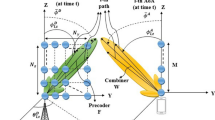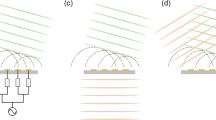Abstract
A flexible hemispherical coverage array antenna based on multi-planar arrays is proposed to meet the growing demands for multi-target TT&C. The advantages and disadvantages of multi-planar arrays and dome phased in engineering implement are compared. Meanwhile, the influence of different number of plane arrays on antenna pattern is analyzed. For the purpose of interference suppression a novel beamforming method by adding constraint conditions is analyzed to enhance the performance of antenna for TT&C system. System simulation is done based on the multi-planar arrays antenna. The feasibility of hemispherical coverage and the performance of anti-jamming are verified. Finally, a comprehensive summary is given.





Similar content being viewed by others
References
Daofeng, X., & Wei, H. (2012). Carrier movement effect on antenna direction of satellite communication on the move. Modern Electronic Engineering, 3(3), 59–62. (in Chinese).
Kuramoto, A., Yamane, T., & Endo, N. (1988). Mechanically steered tracking antenna for land mobile satellite communications. Antennas and Propagation Society International Symposium, 3, 1314–1317.
Fernandes, C. A., Ramos, P. M., & Martins, R. C., et al. (2010). Development of an indoor wireless personal qrea network based on mechanically steered millimeter-wave lens antenna. In Instrumentation and measurement technology conference (I2MTC) (pp. 1091–5281).
Robert, J. M. (2005). Phased array antenna handbook. London.
Tomasic, B. (1998). Analysis and design trade-offs of candidate phased array antenna architectures for AFSCN. New York.
Tomasic, B. (2003). A geodesic sphere phased array antenna for satellite and communication. In IEEE international symposium on phased array systems and technology (pp. 411–416).
Henderson, M., Davis, M. B., & Huisjen, M. (2010). GDPAA Advanced technology demonstration overview and results. In Phased array systems and technology (ARRAY), 2010 IEEE international symposium on. IEEE (pp. 140–143).
Ahn, H., Tomasic, B., & Liu, S. (2010). Digital Beamforming in a large conformal phased array antenna for satellite operations support-architecture, design, and development. In Phased array systems and technology (ARRAY), 2010 IEEE international symposium on. IEEE (pp. 423–431).
Jie, L., & Jianwu, Z. (2005). Analysis of the anti-interference performance of multi-beam satellite antenna. In Microwave, antenna, propagation and EMC technologies for wireless communications, 2005. MAPE 2005. IEEE international symposium on. IEEE, 2005 (Vol. 1, pp. 104–107).
Reiche, E., Stirland, S., & Hartwanger, C., et al. (2011). A dual circular combined K/Ka-band RF sensing feed chain for multi beam satellite antennas. In Antennas and propagation (EUCAP), proceedings of the 5th European conference on. IEEE (pp. 3198–3202).
Herseya, R. K., Melvina, W. L., & McClellanb, J. H. (2004). Clutter-limiteddetection performance of multi-channel conformal arrays. Signal Processing, 84, 1481–1500.
Author information
Authors and Affiliations
Corresponding author
Rights and permissions
About this article
Cite this article
Dianfei, P., Yanshan, B. & Naiping, C. Hemispherical Coverage Array Antenna and Performance Analysis. Wireless Pers Commun 80, 1193–1201 (2015). https://doi.org/10.1007/s11277-014-2080-9
Published:
Issue Date:
DOI: https://doi.org/10.1007/s11277-014-2080-9




